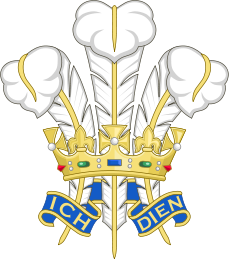Frederick, Prince of Wales
| Frederick | |
|---|---|
| Prince of Wales | |
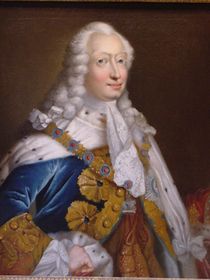 |
|
| Portrait by Jacopo Amigoni, 1735 | |
|
|
|
| Successor | George, Prince of Wales |
| Spouse | Princess Augusta of Saxe-Gotha |
| Issue | |
| Princess Augusta, Duchess of Brunswick George III of the United Kingdom Prince Edward, Duke of York Princess Elizabeth Prince William Henry, Duke of Gloucester Prince Henry, Duke of Cumberland Princess Louisa Prince Frederick Caroline Matilda, Queen of Denmark and Norway |
|
| Full name | |
| Frederick Louis German: Friedrich Ludwig |
|
| House | House of Hanover |
| Father | George II of Great Britain |
| Mother | Caroline of Ansbach |
| Born | 1 February 1707 Hanover, Germany |
| Died | 20 March 1751 (aged 44) Leicester House, London |
| Burial | 13 April 1751 Westminster Abbey, London |
Frederick, Prince of Wales (Frederick Louis; 1 February 1707 – 20 March 1751) was a member of the House of Hanover and therefore of the Hanoverian and later British Royal Family, the eldest son of George II and father of George III, as well as the great-grandfather of Queen Victoria. Under the Act of Settlement passed by the English Parliament in 1701, Frederick was in the direct line of succession to the British throne. He moved to Great Britain following the accession of his father, and was appointed the Prince of Wales. He predeceased his father George II, however, and upon the latter's death on 25 October 1760, the throne passed to Prince Frederick's eldest son, George, Prince of Wales, who reigned as King George III from 1760 until 1820.
Frederick served as the tenth Chancellor of Trinity College, Dublin, from 1728 to 1751.
Prince Frederick had a hostile relationship with his parents.[1]
Contents |
Early life
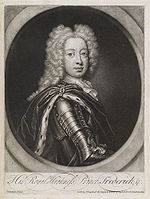
Prince Frederick Louis (sometimes rendered Lewis),[2] the grandson of the then Elector of Hanover (later George I) and Sophia Dorothea of Celle, was born in Hanover, Germany, as Duke Friedrich Ludwig of Hanover. His godparents were his grandfather the Elector and his great-uncle the King in Prussia.[3] His parents, Prince George (later George II) and Margravine Caroline of Ansbach, were called upon to leave the country when their eldest son was only seven years old, and they did not see him again until he arrived in England in 1728 as a grown man. By then, they had several younger children, and they rejected Frederick both as their son and as a person, referring to him as a "foundling" and nicknaming him "Griff", short for the mythical beast known as a griffin.
His grandfather created him Duke of Edinburgh, Marquess of the Isle of Ely,[4] Earl of Eltham in the county of Kent, Viscount of Launceston in the county of Cornwall and Baron of Snaudon in the county of Carnarvon, on 26 July 1726.[5][6] The latter two titles have been interpreted differently since — the "of"s are omitted and Snaudon rendered as Snowdon.
Prince of Wales
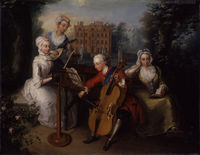
The motives for the ill-feeling between Frederick and his parents may include the fact that he had been set up by his grandfather, even as a small child, as the representative of the House of Hanover, and was used to presiding over official occasions in the absence of his parents. He was not permitted to go to Great Britain until his father took the throne as George II on 11 June 1727. In fact, Frederick continued to be known as Prince Friedrich Ludwig of Hanover (with his British HRH style) even after his father had been created Prince of Wales. Following his father's accession to the British throne, Frederick himself was created Prince of Wales on 8 January 1729.[7]
| British Royalty |
|---|
| House of Hanover |
.svg.png) |
| George II |
| Frederick, Prince of Wales |
| Anne, Princess of Orange |
| Princess Amelia |
| Princess Caroline |
| Prince William, Duke of Cumberland |
| Mary, Landgravine of Hesse-Cassel |
| Louise, Queen of Denmark |
| Grandchildren |
| Augusta, Duchess of Brunswick |
| George III |
| Edward, Duke of York |
| Princess Elizabeth |
| William Henry, Duke of Gloucester |
| Henry, Duke of Cumberland |
| Princess Louisa |
| Prince Frederick |
| Caroline Matilda, Queen of Denmark |
| Great-grandchildren |
| Princess Sophia of Gloucester |
| William Frederick, Duke of Gloucester |
He had a will of his own and sponsored a court of ‘opposition’ politicians at his residence, Leicester House. Frederick and his group supported the Opera of the Nobility in Lincoln's Inn Fields as a rival to Handel's royally-sponsored opera at the King’s Theatre in Drury Lane. Frederick was a genuine lover of music who played the cello; he is depicted as a cellist in an oil portrait by Philip Mercier of Frederick and his sisters, now part of the National Portrait Gallery collection. [28] He enjoyed the natural sciences and the arts, and became a thorn in the side of his parents, thwarting their every ambition and making a point of opposing them in everything, according to the court gossip Lord Hervey. At court, the favourite was Frederick's younger brother, Prince William, Duke of Cumberland, to the extent that the king looked into ways of passing over Frederick in the succession.
A permanent result of Frederick's patronage of the arts is "Rule Britannia", one of the best-known British patriotic songs. It was written by the Scottish poet and playwright James Thomson as part of the masque Alfred which was first performed on 1 August 1740 at Cliveden, the country home of the Prince and Princess of Wales.
A masque linking the Prince with both the ancient hero-king Alfred the Great's victories over the Vikings and with the contemporary issue of building up the British sea power obviously went well with Frederick's political plans and aspirations.
Later the words, set to music by Thomas Arne - another of Frederick's favorite artists - got a permanent life of his own regardless of the masque. Thomson, who supported the Prince of Wales politically, also dedicated to him an earlier major work, Liberty (1734).
Patron of the arts
Unlike the king, Frederick was a knowledgeable amateur of painting, who patronized immigrant artists like Amigoni (illustration above right) and Jean Baptiste Vanloo, who painted the portraits of the prince and his consort for Frederick's champion William Pulteney, 1st Earl of Bath. The list of other artists he employed—Philip Mercier, John Wootton, Phillips and the French engraver Joseph Goupy—represents some of the principal figures of the English Rococo. William Kent's neo-Palladian state barge of 1732 is still preserved, though Sir William Chambers' palace at Kew for his widow Augusta (1757) was demolished in 1802.
Domestic life
Quickly accumulating large debts, Frederick relied for an income on his wealthy friend, George Bubb Dodington. The Prince's father refused to make him the financial allowance that the Prince considered should have been his, and Parliament was obliged to intervene, resulting in further bad feeling between the two.
Although in his youth he was undoubtedly a spendthrift and womaniser, Frederick settled down, on his marriage, in 1736, to the sixteen-year-old Augusta of Saxe-Gotha, and soon became a devoted family man, taking his wife and eight children (his youngest daughter was born posthumously) to live in the countryside at Cliveden, since he was effectively banished from court.
Cricket
By the time Frederick arrived in Great Britain, cricket had developed into the country's most popular team sport and it thrived on gambling. Perhaps because he wished to "anglicise" and so fit in with his new society, Frederick developed an academic interest in cricket that soon became a genuine enthusiasm. He began to make wagers and then to patronise and play the sport, even forming his own team on several occasions.
| Early English cricketers | ||||
|---|---|---|---|---|
| Frederick Louis | ||||
| Personal information | ||||
| Full name | Frederick Louis, Prince of Wales | |||
| Born | 1 February 1707 Hanover |
|||
| Died | 20 March 1751 London, England |
|||
| Role | patron | |||
| Domestic team information | ||||
| Years | Team | |||
| 1731-1750 | Prince of Wales XI and others | |||
|
As of 10 August, 2008 |
||||
The earliest mention of Frederick in cricket annals is in a contemporary report that concerns a major match on Tuesday 28 September 1731 between Surrey and London, played on Kennington Common. No post-match report was found despite advance promotion as "likely to be the best performance of this kind that has been seen for some time". It is interesting that "for the convenience of the gamesters, the ground is to be staked and roped out" which was a new practice in 1731 and could have been done partly for the benefit of a royal visitor. The advertisement refers to "the whole county of Surrey" as London’s opponents and states that the Prince of Wales is "expected to attend".[8]
In August 1732, the Whitehall Evening Post reported that Frederick attended "a great cricket match" at Kew on Thursday 27 July.[9]
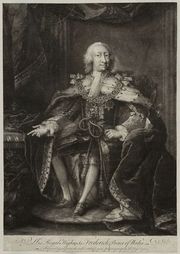
By the 1733 season, he was really getting involved. We read of him giving a guinea to each player in a Surrey v Middlesex game at Moulsey Hurst.[10] Then he awarded a silver cup to a combined Surrey & Middlesex team which had just beaten Kent, arguably the best county team at the time, at Moulsey Hurst on Wed 1 August.[10] This is the first reference in cricket history to any kind of trophy (other than hard cash) being contested. On Friday 31 August, the Prince of Wales' XI played Sir William Gage's XI on Moulsey Hurst. The result is unknown but the teams were said to be of county standard, so presumably it was in effect a Surrey v Sussex match.[11]
In the years following 1733, there are frequent references to the Prince of Wales as a patron of cricket and as an occasional player, though it is doubtful if he was actually any good as a player.
When he died on 20 March 1751, cricket suffered a double impact for his death closely followed that of Charles Lennox, 2nd Duke of Richmond, who was the game's greatest patron. The loss of these patrons had an adverse impact on the game’s finances and the number of top-class matches reduced for some years to come, although economic difficulties arising from the wars of the period certainly inhibited many potential investors.[12]
Later life
His political ambitions remained unfulfilled, because he died prematurely at the age of forty-four. The cause of death has been commonly attributed to an abscess created by a blow by a cricket ball or a tennis ball, but a burst abscess in the lung was given as the cause of death.[13] Frederick died at Leicester House in London and he was buried at Westminster Abbey.
Titles, styles, honours and arms
Titles and styles
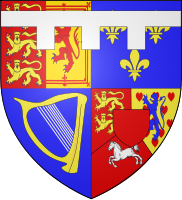
- 1 February 1707–1 August 1714: His Serene Highness Prince Frederick of Hanover
- 1 August 1714–26 July 1726: His Royal Highness Prince Frederick[14]
- 26 July 1726–11 June 1727: His Royal Highness The Duke of Edinburgh
- 11 June 1727–8 January 1729: His Royal Highness The Duke of Cornwall and Edinburgh
- 8 January 1729[15]–31 March 1751: His Royal Highness The Prince of Wales
Arms
Between his creation as Duke of Edinburgh in 1726 and his creation as Prince of Wales, he bore the arms of the kingdom, differenced by a label argent of three points, the centre point bearing a cross gules. As Prince of Wales, the difference changed to simply a label argent of three points.[16] Frederick never succeeded his father as Treasurer of the Holy Roman Empire and so the red escutcheon in the center of his Hanover quarter is blank.[17]
Ancestry and issue
Ancestry
Issue
| Name | Birth | Death | Notes |
|---|---|---|---|
| Princess Augusta, Duchess of Brunswick | 31 August 1737 | 31 March 1813 (aged 75) | Married, 1764, Karl Wilhelm Ferdinand, Duke of Brunswick; had issue. |
| George III | 4 June 1738 | 29 January 1820 (aged 81) | Married, 1761, Charlotte of Mecklenburg-Strelitz; had issue. |
| Prince Edward, Duke of York | 14 March 1739 | 17 September 1767 (aged 28) | |
| Princess Elizabeth | 30 December 1740 | 4 September 1759 (aged 18) | |
| Prince William Henry, Duke of Gloucester | 14 November 1743 | 25 August 1805 (aged 61) | Married, 1766, Maria Waldegrave, Countess Waldegrave; had issue. |
| Prince Henry, Duke of Cumberland | 27 November 1745 | 18 September 1790 (aged 44) | Married, 1771, Anne Horton; no issue. |
| Princess Louisa | 8 March 1749 | 13 May 1768 (aged 19) | |
| Prince Frederick | 13 May 1750 | 29 December 1765 (aged 15) | |
| Caroline Matilda, Queen of Denmark and Norway | 11 July 1751 | 10 May 1775 (aged 23) | Married, 1766, Christian VII, King of Denmark and Norway; had issue. |
Legacy
- Fredericksburg, Virginia, is named after him.
- The town of Fredericton, New Brunswick is named after him.
- The town of Prince Frederick, Maryland, is believed to have been named in the prince's honor.
- Fort Frederick, in Kingston, Ontario, Canada, a fortification consisting mostly of earthworks with a North wall of stone masonry, is named after him. The fort contains one of the Martello Towers, which houses the Royal Military College of Canada museum.
- Fort Frederica, and the surrounding town of Frederica, on St. Simons Island, Georgia, were named for him.
- The only pub in the UK called The Prince Frederick is located at 31, Nichol Lane, Bromley, Kent, BR1 4DE. [29] [30]
- The Prince of Wales' epigram (quoted by William Makepeace Thackeray, "Four Georges"):
-
- "Here lies poor Fred who was alive and is dead,
- Had it been his father I had much rather,
- Had it been his sister nobody would have missed her,
- Had it been his brother, still better than another,
- Had it been the whole generation, so much better for the nation,
- But since it is Fred who was alive and is dead,
- There is no more to be said!"
References
Notes
- ↑ Thomson: Odd Men In, p. 16.
- ↑ The London Gazette for Frederick's knighthood
- ↑ Yvonne's Royalty Home Page: Royal Christenings
- ↑ London Gazette — creation as Prince of Wales
- ↑ London Gazette — creation as Duke of Edinburgh
- ↑ Yvonne's Royalty: Peerage
- ↑ Prince of Wales: Previous princes
- ↑ H. T. Waghorn, The Dawn of Cricket, Electric Press, 1906.
- ↑ G. B. Buckley, Fresh Light on 18th Century Cricket, Cotterell, 1935.
- ↑ 10.0 10.1 H. T. Waghorn, Cricket Scores, Notes, etc. (1730-1773), Blackwood, 1899.
- ↑ Timothy J. McCann, Sussex Cricket in the Eighteenth Century, Sussex Record Society, 2004.
- ↑ From Lads to Lord's; The History of Cricket: 1300–1787
- ↑ Deborah Fisher, Princes of Wales (University of Wales Press, 2006).
- ↑ The London Gazette consistently refers to him as "His Royal Highness Prince Frederick" [1][2][3][4][5][6][7][8][9][10][11][12][13][14][15][16][17][18][19][20][21][22][23][24][25][26][27]
- ↑ Prince of Wales - Previous Princes
- ↑ Marks of Cadency in the British Royal Family
- ↑ Maclagan, Michael; Louda, Jiří (1999), Line of Succession: Heraldry of the Royal Families of Europe, London: Little, Brown & Co, pp. 32, ISBN 0-85605-469-1
Bibliography
- F. S. Ashley-Cooper, At the Sign of the Wicket: Cricket 1742-1751, Cricket Magazine, 1900.
- G. B. Buckley, Fresh Light on 18th Century Cricket, Cotterell, 1935.
- Timothy J. McCann, Sussex Cricket in the Eighteenth Century, Sussex Record Society, 2004.
- A. A. Thomson: Odd Men In: A Gallery of Cricket Eccentics (The Pavilion Library, 1985).
- H. T. Waghorn, Cricket Scores, Notes, etc. (1730-1773), Blackwood, 1899.
- H. T. Waghorn, The Dawn of Cricket, Electric Press, 1906.
- Michael De-la-Noy, The King Who Never Was: The Story of Frederick, Prince of Wales, London; Chester Springs, PA: Peter Owen, 1996.
- John Walters, The Royal Griffin: Frederick, Prince of Wales, 1707-51, London: Jarrolds, 1972.
External links
- Frederick Lewis, Prince of Wales
- Unusual royal deaths at Ward's Book of Days
- From Lads to Lord's; The History of Cricket: 1300 – 1787
- Henry Churchyard "Royal Genealogies, Part 9"
- Sam Sloan "Big Combined Family Trees (pafg744)"
|
Frederick, Prince of Wales
House of Hanover
Cadet branch of the House of Welf
Born: 1 February 1707 Died: 31 March 1751 |
||
| British royalty | ||
|---|---|---|
| Preceded by George, Prince of Wales later became King George II |
Heir to the Thrones as heir apparent 11 June 1727 – 31 March 1751 |
Succeeded by Prince George later became King George III |
| Prince of Wales 1729 – 1751 |
||
| Peerage of England | ||
| Preceded by George, Prince of Wales later became King George II |
Duke of Cornwall 1727 – 1751 |
Vacant
Title next held by
Prince George Augustus Fredericklater became King George IV |
| Peerage of Scotland | ||
| Preceded by George, Prince of Wales later became King George II |
Duke of Rothesay 1727 – 1751 |
Vacant
Title next held by
Prince George Augustus Fredericklater became King George IV |
| Peerage of Great Britain | ||
| New creation | Duke of Edinburgh 1st creation 1726 – 1751 |
Succeeded by Prince George later became King George III |
|
||||||||||||||||||||||||||||||||||||||
|
|||||||
|
|||||||||||
|
|||||||
|
|||||
